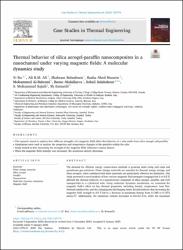| dc.contributor.author | Ru, Yi | |
| dc.contributor.author | Ali, Ali B. M. | |
| dc.contributor.author | Babadoust, Shahram | |
| dc.contributor.author | Hussein, Rasha Abed | |
| dc.contributor.author | Al-Bahrani, Mohammed | |
| dc.contributor.author | Abdullaeva, Barno | |
| dc.contributor.author | Salahshour, Soheil | |
| dc.contributor.author | Sajadi, S. Mohammad | |
| dc.contributor.author | Esmaeili, Sh | |
| dc.date.accessioned | 2025-03-17T07:46:23Z | |
| dc.date.available | 2025-03-17T07:46:23Z | |
| dc.date.issued | 2025 | en_US |
| dc.identifier.citation | Ru, Y., Ali, A. B., Babadoust, S., Hussein, R. A., Al-Bahrani, M., Abdullaeva, B., ... & Esmaeili, S. (2025). Thermal behavior of silica aerogel-paraffin nanocomposites in a nanochannel under varying magnetic fields: A molecular dynamics study. Case Studies in Thermal Engineering, 66, 105778. | en_US |
| dc.identifier.issn | 2214-157X | |
| dc.identifier.uri | https://hdl.handle.net/20.500.12960/1708 | |
| dc.description.abstract | The demand for efficient energy conservation methods is growing amid rising fuel costs and greenhouse gas emissions. Phase change materials are essential for thermal energy storage, and silica aerogels, when combined with these materials, are particularly effective for insulation. This study presented a novel analysis of how various magnetic field strengths (ranging from 0 to 0.5 T) affected the thermal behavior of a nanostructure composed of silica aerogel, paraffin, and CuO nanoparticles in a cylindrical tube. Using molecular dynamics simulations, we examined the magnetic field's effect on key thermal properties, including density, temperature, heat flux, thermal conductivity, and the charging and discharging times. Results indicate that increasing the magnetic field strength to 0.5 T led to a decrease in maximum density from 0.1385 to 0.1372 atoms/& Aring;3. Additionally, the maximum velocity increased to 0.0142 & Aring;/fs, while the maximum temperature and heat flux rose to 646 K and 72.13 W/m2, respectively. The observed charging and discharging times were 5.91 ns and 8.52 ns, with stronger magnetic fields expediting the charging phase. These findings offer valuable insights into optimizing thermal energy storage systems through magnetic field modulation. | en_US |
| dc.language.iso | eng | en_US |
| dc.publisher | Elsevier Ltd. | en_US |
| dc.relation.ispartof | Case Studies in Thermal Engineering | en_US |
| dc.relation.isversionof | 10.1016/j.csite.2025.105778 | en_US |
| dc.rights | info:eu-repo/semantics/openAccess | en_US |
| dc.subject | Phase change materials | en_US |
| dc.subject | Silica aerogel | en_US |
| dc.subject | Paraffin | en_US |
| dc.subject | Nanoparticles | en_US |
| dc.subject | Molecular dynamics simulation | en_US |
| dc.subject | Magnetic field | en_US |
| dc.title | Thermal behavior of silica aerogel-paraffin nanocomposites in a nanochannel under varying magnetic fields: A molecular dynamics study | en_US |
| dc.type | article | en_US |
| dc.authorid | 0000-0003-1390-3551 | en_US |
| dc.department | Fen Edebiyat Fakültesi, Matematik Bölümü | en_US |
| dc.contributor.institutionauthor | Salahshour, Soheil | |
| dc.identifier.volume | 66 | en_US |
| dc.identifier.startpage | 1 | en_US |
| dc.identifier.endpage | 11 | en_US |
| dc.relation.publicationcategory | Makale - Uluslararası Hakemli Dergi - Kurum Öğretim Elemanı | en_US |

















